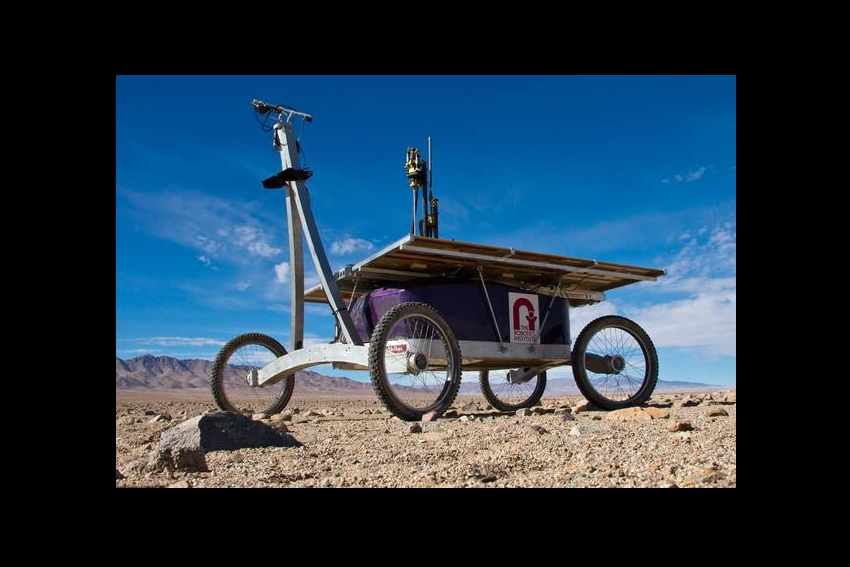AUT research to find life on Mars

Scientists agree that any signs of life on Mars will likely be found below the surface but how widely will they have to search? AUT microbiologists are working with NASA to answer these questions in the lead up to the space agency’s 2020 Mars mission.
Chile’s Atacama Desert is one of the driest and most Mars-like environments on Earth which makes it central to understanding life pushed to its limits. When NASA wanted to test the equipment that will search for life signatures on Mars and understand how life is distributed, they looked to the Atacama.
In a trial mission, researchers went to the Atacama to test a prototype NASA autonomous rover’s ability to collect soil from below the surface and determine the distribution of bacteria in the nearly lifeless soil.
The success of the rover being able to take sub-surface samples was important because most scientists agree that any life on Mars would have to occur below the surface to escape the harsh surface conditions where high radiation, low temperature and lack of water make life unlikely.
The samples were processed and analysed in New Zealand by AUT microbial scientists, Dr Stephen Archer who extracted the DNA and Dr Kevin Lee who carried out the bioinformatics on the data. They found the soil contained unusual and highly specialised microbes distributed in patches, which the team linked to the limited water availability, scarce nutrients and geochemistry of the soil.
The microbes were adapted to high salt levels, similar to what may be expected in the Martian subsurface. Research lead, Yale-NUS College Professor Stephen Pointing (formerly of AUT) says, the microbes are very different from those previously known to occur on the surface of deserts.
The findings published in the journal Frontiers in Microbiology will aid the search for evidence of signs of life during future planned missions to Mars.
In 2020 both NASA and the European Space Agency will embark on missions to deploy rovers on the surface of Mars. They will search for evidence of past or present life and for the first time, drill below the surface where refuges for simple microbial life may still exist.
“Finding life or even traces of past life will address one of the greatest scientific questions of all time; whether life evolved on more than one planet. If life is found on Mars, it improves the chances of discovering life elsewhere in the galaxy,” explains Pointing.
To help ensure space missions succeed, technology is rigorously tested on Earth first. The core of the Atacama Desert in Chile is extremely dry, experiencing decades without rainfall. It has high surface UV radiation exposure and is comprised of very salty soil. It’s the closest match we have on Earth to Mars, which makes it good for testing simulated missions to this planet.
Funded by NASA, an autonomous rover-mounted robotic drill and sampling device, designed by Carnegie-Mellon’s Robotics Institute, was deployed in the Atacama Desert to test if it could successfully recover sediment samples down to a depth of 80cm. Pointing and his colleagues compared samples recovered by the rover to soil samples carefully taken by hand. Using DNA sequencing, they found that bacterial life in the sediments recovered by both methods were similar, indicating a successful deployment, but it also revealed that microbial life was very patchy and related to the limited water availability, scarce nutrients and geochemistry of the soil.
“These results confirm a basic ecological rule that microbial life is patchy in Earth’s most extreme habitats, which hints that past or present life on other planets may also exhibit patchiness,” explains astrobiologists Nathalie Cabrol and Kim Warren-Rhodes of The SETI Institute and co-authors of the study. “While this will make detection more challenging, our findings provide possible signposts to guide the exploration for life on Mars, demonstrating that it is possible to detect life with smart robotic search and sampling strategies.”
Pointing highlights that future research includes drilling deeper to understand just how far down recoverable microbes occur.
“Mars missions hope to drill to approximately 2m and so having an Earth-based comparison will help identify potential problems and the interpretation of results once rovers are deployed there. Ecological studies that help us predict the habitable areas for microbial communities in Earth’s most extreme environments will also be critical to finding life on other planets.”
Stephen Archer, Kevin Lee and Stephen Pointing are also co-authors of a paper published last week in Nature Microbiology on Antarctic air samples. Stephen Archer collected and processed the samples and Kevin Lee did the bioinformatics.
Read a blog post related to this article on the Nature Microbiology Community site
Additionally, Stephen and Kevin will be embarking on a global research expedition related to this work including 11 countries.